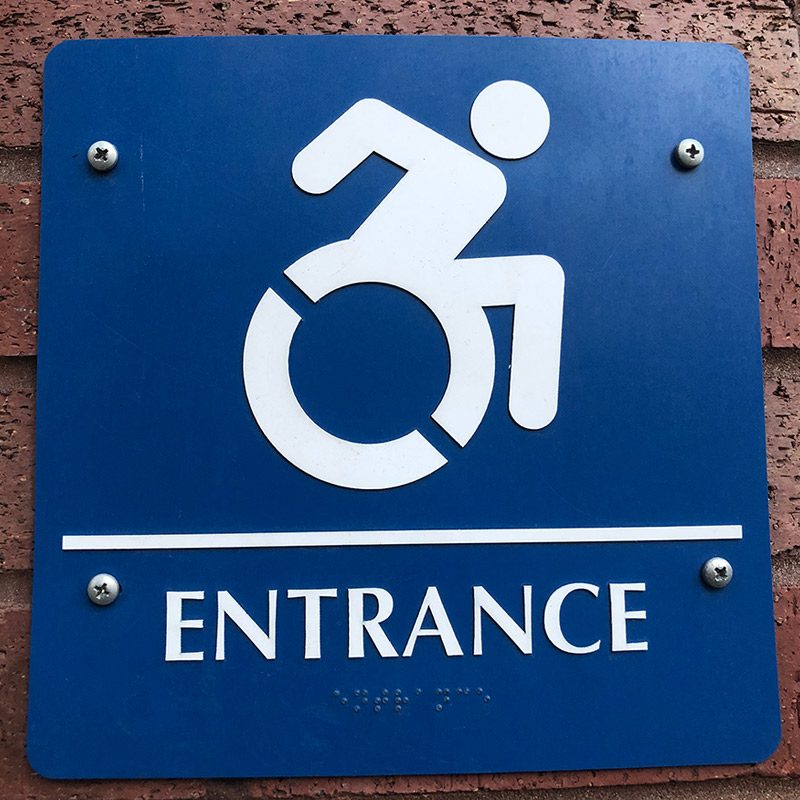ADA Signs: Necessary Tools for Inclusive Settings
ADA Signs: Necessary Tools for Inclusive Settings
Blog Article
Discovering the Secret Functions of ADA Signs for Boosted Ease Of Access
In the world of ease of access, ADA indications serve as quiet yet effective allies, guaranteeing that rooms are inclusive and navigable for people with handicaps. By integrating Braille and responsive aspects, these signs break barriers for the aesthetically damaged, while high-contrast color systems and understandable typefaces provide to varied visual demands.
Value of ADA Conformity
Making sure conformity with the Americans with Disabilities Act (ADA) is crucial for promoting inclusivity and equivalent accessibility in public spaces and work environments. The ADA, passed in 1990, mandates that all public facilities, employers, and transportation services fit people with specials needs, guaranteeing they delight in the exact same legal rights and chances as others. Conformity with ADA requirements not just meets lawful commitments yet likewise improves a company's online reputation by showing its commitment to diversity and inclusivity.
One of the crucial facets of ADA compliance is the implementation of accessible signs. ADA signs are developed to ensure that people with handicaps can conveniently browse via structures and spaces.
Additionally, sticking to ADA guidelines can alleviate the danger of prospective fines and lawful effects. Organizations that stop working to abide by ADA guidelines might deal with claims or penalties, which can be both financially troublesome and harmful to their public photo. Therefore, ADA compliance is integral to fostering a fair environment for everybody.
Braille and Tactile Components
The consolidation of Braille and tactile aspects into ADA signs symbolizes the principles of access and inclusivity. It is generally positioned beneath the matching message on signage to make certain that people can access the information without aesthetic aid.
Responsive elements prolong beyond Braille and consist of raised symbols and characters. These parts are developed to be noticeable by touch, enabling individuals to recognize area numbers, washrooms, exits, and other essential areas. The ADA sets particular guidelines concerning the dimension, spacing, and placement of these responsive aspects to enhance readability and ensure consistency across different environments.

High-Contrast Color Design
High-contrast color pattern play a critical function in improving the visibility and readability of ADA signs for individuals with aesthetic problems. These systems are important as they make the most of the distinction in light reflectance in between message and history, making certain that indicators are quickly discernible, even from a range. The Americans with Disabilities Act (ADA) mandates the use of certain shade contrasts to suit those with minimal vision, making it an essential aspect of conformity.
The effectiveness of high-contrast colors directory exists in their capability to stick out in numerous lights problems, consisting of dimly lit environments and areas with glare. Normally, dark message on a light background or light message on a dark history is used to accomplish optimal comparison. For example, black text on a white or yellow background offers a raw visual distinction that helps in fast acknowledgment link and understanding.

Legible Fonts and Text Dimension
When thinking about the layout of ADA signage, the choice of clear typefaces and ideal message size can not be overemphasized. These components are essential for making certain that indicators come to individuals with visual disabilities. The Americans with Disabilities Act (ADA) mandates that font styles need to be sans-serif and not italic, oblique, script, very ornamental, or of uncommon type. These needs aid guarantee that the text is quickly legible from a range and that the personalities are distinguishable to diverse target markets.
According to ADA guidelines, the minimal text elevation ought to be 5/8 inch, and it must increase proportionally with watching range. Uniformity in message size adds to a natural aesthetic experience, helping individuals in browsing environments effectively.
Moreover, spacing in between lines and letters is important to readability. Ample spacing prevents personalities from showing up crowded, improving readability. By adhering to these requirements, designers can substantially boost ease of access, ensuring that signs offers its desired purpose for all people, no matter their aesthetic abilities.
Efficient Positioning Approaches
Strategic positioning of ADA signs is essential for optimizing accessibility and ensuring compliance with lawful criteria. ADA standards state that indications must be installed at a height between 48 to 60 inches from the ground to guarantee they are within the line of view for both standing and seated individuals.
Furthermore, signs should be positioned nearby to the lock side of doors to permit simple recognition prior to entry. Uniformity in sign positioning throughout a facility boosts predictability, minimizing confusion and enhancing overall user experience.

Verdict
ADA indications play a crucial duty in advertising ease of access by integrating functions that resolve the requirements of people with specials needs. These components jointly promote an inclusive setting, underscoring the importance of ADA conformity in making certain equivalent gain access to for all.
In the realm of accessibility, ADA signs offer as quiet yet effective allies, guaranteeing that rooms are accessible and inclusive for individuals with disabilities. The ADA, established in 1990, mandates that all public centers, companies, and transport services fit people with handicaps, guaranteeing they take pleasure in the exact same legal rights and opportunities as others. ADA Signs. ADA indicators are made to make sure that individuals with impairments can easily browse through structures and areas. ADA standards state that signs need to be installed at a height between 48 to 60 inches from the ground to guarantee they are within the line of sight for both standing and seated people.ADA signs play a vital duty in advertising access by integrating attributes that deal with the demands of individuals with disabilities
Report this page